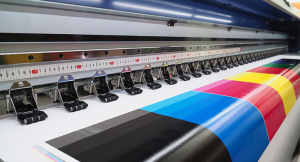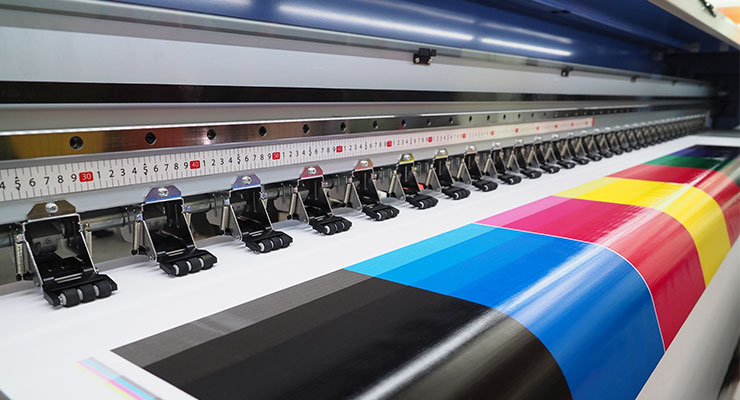Global Inkjet Printers Market Expects to Grow
Global Inkjet Printers Market Expects to Grow
The global inkjet printers market size was valued at $34.24 billion in 2019 and is expected to expand at a compound annual growth rate (CAGR) of 5.3% from 2020 to 2027.
The packaging industry is witnessing a rapid growth across the globe due to huge demand from the e-commerce transport and shipment, food and beverages, personal care, household care, and healthcare industries for convenience-based packaging. This growth is creating a massive demand for inkjet printers for packaging purposes, which one of the major factors driving the market.
 Inkjet printers are non-contact printers that recreate a digital image by propelling droplets of ink through nozzles on the paper and plastic substrates. The inkjet technology comprises ionized ink which is directed by magnetic plates to spray on to the paper. These printers are used in various industries such as advertisement, textile, packaging, education, and pharmaceutical.
Inkjet printers are non-contact printers that recreate a digital image by propelling droplets of ink through nozzles on the paper and plastic substrates. The inkjet technology comprises ionized ink which is directed by magnetic plates to spray on to the paper. These printers are used in various industries such as advertisement, textile, packaging, education, and pharmaceutical.
The rapidly growing advertisement industry, coupled with increasing demand for higher print resolution and better print quality, is anticipated to drive market growth.
Large format printers are used majorly to advertise products on banners, posters, signage boards, billboards, and hoardings. Banners and billboards consist of detailed information including images, graphics, and logos to capture the attention of viewers.
Thus, marketers prefer large format printers to print visual campaigns-including graphic-rich posters and banner advertisements with a high-quality images-for display in offices or public spaces. It gives advertising and marketing professionals the power to develop brand awareness and improve visibility for a product/ service in a specific industry.
Furthermore, large format printers are used by photographers to print photographs without pixel split, proper color, and combination on any substrate.
Inkjet printers were initially designed for use in coding and marking applications in packaging.
However, these printers are now being used in various other industries such as textile and healthcare industries. There have been several advancements in textile printing techniques from block printing to the rotary screen printing machine and dry heat transfer printing.
In recent years, digital printing has evolved as the latest innovation, wherein it involves the artwork to be processed by a desktop and then printed directly on to the fabric. In addition, digital printing offers various benefits over other conventional printing techniques, including screen printing.
The textile inkjet printer with digital printing helps the manufacturer to print in different colors, designs, and patterns on the same fabric with higher operating speed, ranging up to 1000 meters per minute, as compared to screen printing.
On the other hand, factors such as the high operating speed of digital printing as compared to other printing techniques such as screen printing, dry heat transfer printing for bulk printing-and increasing use of laser printer, are anticipated to hinder the market growth over the forecast years.
The laser printers act as a substitute for inkjet printers, thereby posing a potent threat to the latter. The laser printer offers lower running costs and has high printing capacity as compared to an inkjet printer. In addition, ink refilling and replacing are expensive and can dry up if the printer is not used for long, causing blockages within the printer.
However, there are certain advantages of inkjet printers over laser printers, such as lightweight and compact size, which requires less space, easy setup process, less war-up time, and low startup cost-as compared to laser printers.
The multifunctional printer segment accounted for the largest revenue share of 24.62% in 2019 and is expected to grow considerably over the forecast period.
This is attributable to the integrated features of multifunctional printers such as high-speed, multifunctional capabilities including copy, print, scan and fax into one machine, and affordability. Furthermore, the growing demand for multifunctional printers in the healthcare sector is one of the major factors positively impacting the market in the coming years.
Sharing patient information timely and securely and store patient information digitally is increasing the demand for multifunctional printers in the healthcare sector. For instance, Xerox Corporation’s multifunctional printers allow healthcare providers to share patient-related vital information through a secure electronic medium.
Moreover, multifunctional printers are widely used across corporate offices and academic institutions, such as colleges and schools. The flexibility of these printers to copy, print, paper handling, scan, and fax has boosted the demand for multifunctional printers in educational institutes.
In addition, several multi-functional inkjet printers are now available with connectivity options for Wi-Fi, LCD screen, USB, touch, and Bluetooth, which makes these printers more controllable and user-friendly. The cost-effectiveness coupled with the low variants of these printers has boosted the use of multifunctional over single functional inkjet printers.
The Continuous Ink Jet (CIJ) printer segment accounted for the largest revenue share of 37.73% in 2019 and is expected to grow considerably over the forecast period. This is attributable to the lower maintenance cost, minimum leak of Volatile Organic Compounds (VOCs), and the option to fill different types of inks, among others.
Technology-based printers offer sealed cartridge-based systems for ink delivery, which simplifies replacement while reducing the possibility of the spill. Thus, end-users’ preference for Continuous Ink Jet (CIJ) printer is anticipated to boost the market demand in the coming years.
Printers with Drop on Demand (DOD) inkjet technology are expected to emerge as the fastest-growing segment over the forecast period. The benefits offered by DOD in terms of flexibility, reduced downtime, and functionality are the major factors propelling the segment growth in the coming years.
In a DOD system, the liquid is ejected from the print head only when a drop is necessary. The DOD inject printer print-head comprises numerous individual valves-including 7, 16, or 32-that print dots at regular intervals. The DOD inkjet printers are majorly used in various industrial applications, such as printing on plasterboard, plastics, timber and hardware, metals, packaging, and concrete products.
The industrial end-user segment accounted for the largest revenue share of 24.12% in 2019 and is expected to grow with the highest growth rate of 6.9% over the forecast period.
This is attributed to the higher operating speed of industrial inkjet printers. The high-speed drop ejection enables the high operational speed of these printers for coding and marking of products along with high velocity. High velocity allows the nozzle to be positioned at a significant distance from the product, which enables manufacturers to design products of different sizes and shapes.
Besides, these printers can also print on a cylindrical surface, which increases its adoption in the cylindrical products industry that includes small drums, bottles, and pipes.
The industrial segment comprises packaging, publishing and photography. The packaging segment accounted for the largest revenue share of 54.54% in 2019 and is anticipated to continue its dominance in the forthcoming years. The packaging industry uses large format inkjet printers to print high-quality labels and packages. These large format printers offer several benefits, such as fast turnaround time, low printing cost, and flexibility.
North America accounted for the largest revenue share of 29.21% in 2019.
Asia Pacific is expected to emerge as the fastest-growing regional segment over the forecast period. The growth is attributed to the substantial opportunities based on low labor cost and low manufacturing cost, which makes Asia-Pacific a prominent location for setting up production plants mass production of inkjet printers.
The recent outbreak of the COVID-19 pandemic globally has adversely impacted the regional growth. China is a prominent supplier of films and foils used in packaging printing is expected to be highly affected by the COVID-19 pandemic. Also, various European printing companies depend on China for the supply of chemicals that are used as input materials in printing procedures, such as constituents of solvents and inks.
Source: https://www.inkworldmagazine.com/
Related:
LockDown Drives Up Inkjet Sales in Europe




Leave a Comment
Want to join the discussion?Feel free to contribute!